Art of the Genre: Orcus
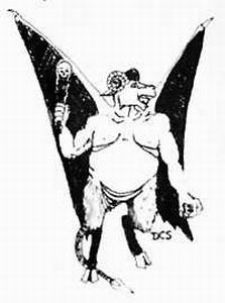
Orcus, Prince of the Undead. He’s an ancient legend, more so than any D&D text, but for the purpose of this article I’m going address the Gygaxian version and not the Etruscan.
Why Orcus? Well, because I’m upset with Orcus, that’s why. I feel like the big fella let me down. Once, back in the long, long, ago, I got the original AD&D Monster Manual, and in those pages I found the section on Demons and was captivated by it.
Here stood the tentacle-armed Demogorgon, and slime-spurting Juiblex, and the flail-wielding Yeenoghu, Demon Lord of Gnolls, but of all of them, Orcus jumped out into my imagination because he was so drastically different.
Orcus was this fat demon with a wand [I mean really, what self-respecting demon lord carries a wand?] He had the cloven hooves and legs of a goat, a beer belly, and the head of a ram. He wasn’t cool, or epic, and certainly wasn’t someone who would fill you with fear, but the reality in his visage gave me pause. 
I looked at that silly wand, this ebon shafted and skull topped device, and quickly discovered if it touched you, you either died or worse yet were completely annihilated. Now that’s a power! No gaming mechanics built saving throw, no second chances, just dead… D-E-A-D, dead! That is 1st edition AD&D at its best, the ‘no chance’ rule well enforced, and Orcus simply one of those creatures you don’t mess with.
He was what he was, a gluttonous demon who overindulged in the heaping buffet of human suffering, spite, bile, and contempt. Oh yeah, that’s what I’m talking about, and I think others feel the same way considering his popularity among his rather lofty brethren. 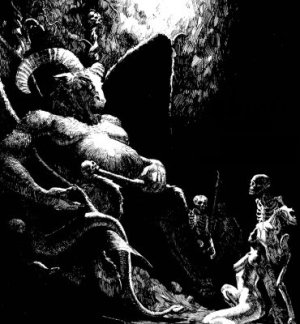
David C. Sutherland III, the MMI artist who first depicted him, had it right. Perhaps not as malevolent as could have been done, but still correct in what he was, un-beautiful. I grew to enjoy this rendition from 1979, and it settled into my mind that not everything about power had to be lovely.
Strangely enough my second visual record of Orcus comes from Todd Lockwood… in 1981. Yep, you heard me right, 1981. The same year Elmore, Easley, and Holloway were starting their careers under Jim Roslof at TSR, Todd was submitting pieces to Dragon Magazine. To think that Lockwood, as huge as he is now, could have actually been one of ‘The Big Four’ of TSR if life had turned out a bit differently kind of blows my mind. Instead, he went into advertising, and it took another decade and a half for him to find his way into the TSR pit.
Anyway, Lockwood, true to his nature of extreme precision, created the epitome of Orcus in his rendition. This is what Sutherland didn’t have the space for in the Monster Manual. Todd captures Orcus in all his obese glory. Man-breasts hanging, gut bulging, and yet a power lays over his visage, his uncaring eye languishing on the sweet flesh of the sacrifice his undead minions have brought him. Here is the first glimpse of the general malaise of death, the inevitability of the sacrifice, and the utter melancholy of this prince’s realm. 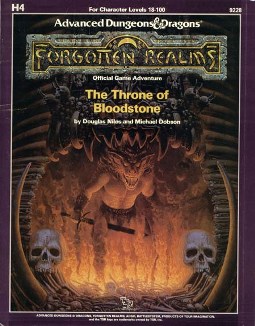
I love this picture, and it represents Orcus at his height, well before he found his way into the cast of The Biggest Loser…
Enter Keith Parkinson and the 1986 module H2 The Mines of Bloodstone. Here, Keith depicts the body-building Orcus, all angled pectorals and washboard abs, but I find the biggest affront to Orcus perpetrated on the cover of H4 The Throne of Bloodstone. This almost blasphemous image strips Orcus [assuming this creature on the cover is indeed the Demon Prince of the Undead] of his horns, his bloated body, and even his wand. He’s more a furry-chested Conan than the Orcus of old.
This change, one to a more visual acceptability aspect, still kind of slunk away into an afterthought for a decade until AD&D 3rd Edition brought forth the inclusion of Orcus into the Book of Vile Darkness. This time Orcus was ‘upgraded’ one further, the story indicating he’d died, risen from the grave [well, he is the demon prince of the Undead after all], and his newest incarnation was something more meant for battle.
I call Art Director tampering! This time around Arnie Swekel got the honor of the Orcus redux, the demon lord losing the more human-like flesh and hairy chest of Parkinson with the rather satanic red skin of a full-blood Tanar’ri [the new politically correct name for Demon spawned in the Planescape setting]. He did, however, retain the Parkinson cut musculature and svelte waistline even as he reclined on a throne of corpses with his glowing-skulled wand back in its proper place of honor. 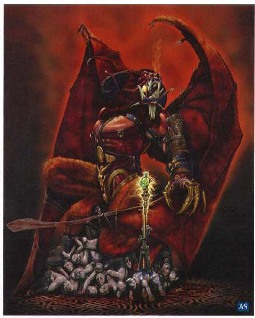
The constant revision continued with Wayne Reynolds in later 3.5 Edition AD&D works, his version harkening back a bit to the original in that although Orcus is wearing a trim-fitting girdle, he still has some girth, but his muscles have definitely gone through a rigorous ingestion of Human Growth Hormones that makes Barry Bonds look like an amateur. In Reynolds tribute, Orcus is battle incarnate, a raging bull of a destroyer with his wand transformed into a mace-like weapon of undeniable evil [although you get a saving throw this time…].
And you know, 4E AD&D has done no better, only worsening the matter by taking away the belly completely and upping the fury factor.
So in twenty years Orcus has gone from a fat goat with a simplistic wand to a rampaging minotaur wielding a gladiatorial-inspired mace. In some ways, that’s a reflection of our society, the subdued and dreamy 70s where we saw shiny epics like Star Wars as our inspiration giving way to the corporate glam of reality TV and video games that contain more sex and blood than Caligula’s court. 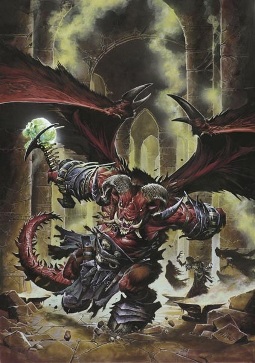
Orcus has succumbed to the new millennia media like a teenage girl with an eating disorder. He longs to be on the cover of Men’s Health, and in so doing loses the bulk [no pun intended] of what I’d consider his edge. I long for the days when hair on a man’s chest was acceptable, when your dad had boobs and a beer gut but nobody cared. This new breed of human ideal mocks what Orcus is all about.
In no simple terms he’s the Demon Prince of DEATH! He’s all about decay, rot, and of going to pot while enjoying the decline. Why waste his talents on body building, I mean he’s going to get you in the end, right? He knows this, it feeds him, and we should embrace his girth and devil-may-care [apologies to all the demons out there, but its slang] attitude.
Don’t let this hard-body veneer fool you, remember the good old days, the times when water came from a tap instead of a petroleum-based bottle, and diet drinks like Tab confused the general population with their hot pink branding and strange things called ‘calories’.
Orcus has become a fallen icon, fallen to beauty and better hygiene, but if you’re still playing RPGs, and if jeweled dice mean something to you, I say roll back the clock and give the old Orcus a shot. He’ll do you right, I promise, because you know, Sutherland and Lockwood had this lord’s true colors, even in simple black and white.
Great article, Scott! “Simple but effective, I promise.” No kidding.
But where is that Todd Lockwood scan from? What article?
John: Good question. The image appears in Dragon Magazine #42 from October 1980! Earlier than I thought, and an interesting story is that when Lockwood got to TSR in 1997, WotC was moving the business to Seattle and some warehouse guys found the original and gave it to Todd. He then turned to David ‘Diesel’ LaForce, handed him the original, and said ‘Never say I didn’t give you anything.’
Scott,
Who knew Orcus had changed so much? Well, ok, you did and what an interesting and informative read your essay was this week.
Your essay reminded me of a poster that was created by Mark Allen late last year. Here’s a link to a website, (Grognardia), that mentioned it: http://grognardia.blogspot.com/2010/09/cool-labyrinth-lord-poster.html
I really like how Mr. Allen captures the original look and feel of Orcus and how totally overwhelmed the party appears. It doesn’t look good for them to say the least.
Have other iconic creatures changed as much as Orucs? For example, how has Tiamat fared after all these years?
Great subject, Scott! I love the Lockwood Orcus best of all, too. When I look at the WAR Orcus, and the miniature (megature?) that evidently is based on it (and which I had to have), I am convinced that the girdle that Orcus now wears is a Girdle of Greater Gut Withholding, +8.
Zachary: Good call on the Mark Allen poster. I recommend it, too.
Zachary [not Jachary like last week, where is my head sometimes 🙂 ]: I saw that Mark Allen piece over on Dragonsfoot ‘guarding’ a collection of old D&D swag. Too funny, but yes, it’s an outstanding Orcus piece.
Tiamat is an interesting topic. I’m currently knee deep Jeff Easley’s biography, and he’s had a hand in Tiamat for sure. I’ll look into it, but John O’Neill and others have asked me about doing other Demon Lords, so we might see them first 😉
Oh, and as for Critical Hit, the first three comics just went to the creative director, so I think we’re getting very close.
Theodric: Yeah, you got to love the ‘big guy’. +8 Girdle of Greater Gut Withholding!!!!! 🙂 ROFL, don’t we all need one of those?
Post about Orcus=made of win.
And yeah, give me grossly fat, old school demon lord any day.
[…] Orcus. He was one of the bad boys of the demon realms of D&D way back when I started playing in the early 1980s. The Wand of Orcus always held a particular strange fascination for some reason… Scott Taylor over at Black Gate (an amazing indie magazine for fantasy stories btw!) has written a great article that pulls together Orcus artwork at Art of the Genre: Orcus. […]
Brian: Thanks for the ‘win’. Does that mean, like Charlie Sheen, I’m officially ‘winning’ 😉
The title of the cover for H4 Throne of Bloodstone is, apparently, “Orcus’ Doorman” (link. So, nope, that’s not Orcus.
What I believe is the same guy can be seen on pg. 60 of the module (with a slightly different interpretation of how the scene should be depicted). Oddly, the encounter described on pg. 63 involving the skulls and the doorman actually involves a cloned duplicate of one of the PCs challenging them to a one-on-one duel.
Justin: I’d wondered about that, as Parkinson does a much better Orcus on H2 coming out of the summoning pool [still ripped however, but more to the point]. As I don’t own H4 [have you seen the price of Bloodstones on Ebay?] I couldn’t confirm, but thanks for letting me know! 🙂